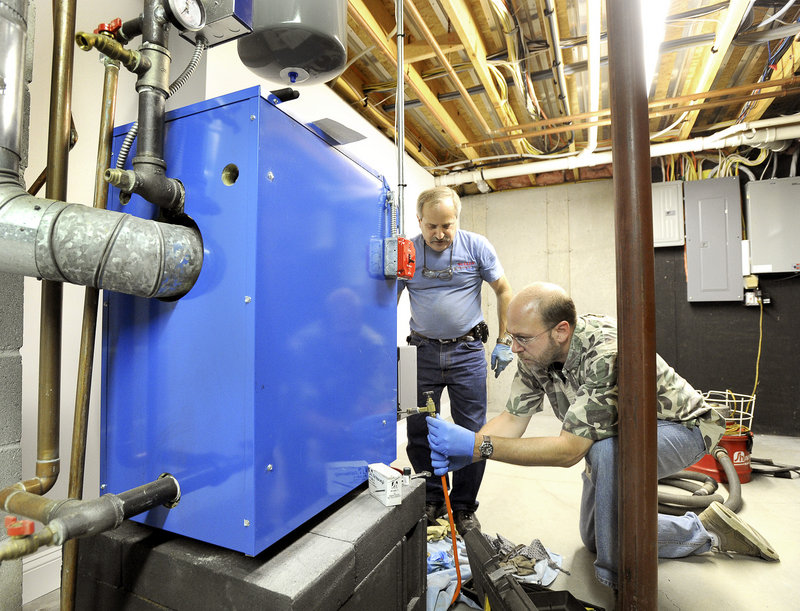SCARBOROUGH – After 40 years of fixing and cleaning furnaces, Phil Rossetti is quick to point out that he gets to meet a lot of people.
Interesting people. People who might be good to know.
Like the time Rossetti was doing a heating system tuneup in a customer’s basement, and twisted his knee. At first, doctors thought it was a sprain, then later realized he had torn his meniscus. So they sent him to a specialist.
“I walked in the doctor’s office, not paying any attention to the name,” said Rossetti, a master heat technician with Muller Heating & Plumbing of Scarborough. “It was his (the doctor’s) house I was doing when I hurt my knee. He said ‘Phil, I’m going to do your knee.’ I said, ‘You better do a good job or you’ll freeze this winter.’ “
Rossetti told me this story in the basement of a large, modern home in Scarborough, where he was doing an annual cleaning of an oil-fired heating system. He had cloths and rags strategically placed around the basement — under the filters on the oil tanks, in front of the burner, under the fuel line.
He also had buckets and rags placed around the room.
“You can’t avoid a little dripping here and there, but I try to leave it as clean as I can,” said Rossetti, 58, of Gorham.
He began by telling me that a normal cleaning should take “a full hour and a half” and more time than that if there are problems. He explained to me everything he does, and I could see why.
He started by lugging his tools and buckets and vacuum into the basement, which took about 10 or 15 minutes. Then he spread out cloths and rags and tools.
Then I helped him “blow out” the sediment and muck that had built up in the home’s two oil tanks. Rossetti turned off a series of valves and disconnected the fuel line from the oil burner. Then he had me screw a CO2 cartridge onto the line going to one oil tank, and press down on it.
I could hear a loud splash reverberating through the oil tank, with a little rattling noise as well.
“Did you hear that? There was definitely some stuff in there,” Rossetti said.
After we blew the sediment out of the tanks, we changed the filter for each tank. Rossetti did most of the work because speed was of the essence. After he unfastened the lid to the filter housing, thick black liquid came flowing out. He put one bucket underneath it, which filled up so fast he had to put a second bucket underneath it.
“Always have two buckets ready,” he told me, as he knelt on a green foam pad and quickly changed the filter. “And always have something for your knees.”
He also told me, as a homeowner, that I should always look for a listing for “CO2” on the bill for my annual furnace cleaning. If that’s not there, it means my fuel tank lines weren’t cleaned out, and that can lead to problems.
Back at the main heating unit — a burner attached to a boiler — Rossetti explained to me that this particular unit was a sophisticated one and, therefore, a little different from some units he’ll work on. Then again, every unit is a little different.
We used adjustable wrenches to disassemble the unit into six or seven separate pieces. Rossetti showed me the parts, including one that had a small computer board in it. This was the brains, he told me. He then explained that there was a little “eye” or sensor that would know if the burner unit was on, by “seeing” the light of the flame. To aid this process, he sprayed an internal tube with reflective paint, to help the light show up better.
He also opened the burner to show me a ton of residue and soot that had collected. He then handed me a vacuum and, with my head nearly in the burner, I scraped and vacuumed up the particles.
Not every boiler works the way this one does, Rossetti told me, so not every boiler would have this kind of buildup. But in this case, we needed to clean it up.
Rossetti and I also disassembled the tube that connects the boiler to the chimney and cleaned dusty buildup out of that. He also had me stick my hand into the chimney.
“If it’s not clogged, you should feel the air,” Rossetti said. And I did indeed feel the air.
As Rossetti worked and I helped, we were both in relative comfort. The basement was extremely clean, with plenty of headroom.
But some places Rossetti works in have cobwebs or critters or water. And sometimes, he works for hours on his stomach in a crawl space, fixing and cleaning heating systems in homes with no basement at all.
“I did a place near Two Lights (in Cape Elizabeth) where the pipes froze and I spent a 12-hour day working in a crawl space,” he said.
But Rossetti doesn’t seem to mind. Different people, different basements, different challenges.
“I like meeting all kinds of people and troubleshooting their problems for them,” Rossetti said.
Staff Writer Ray Routhier can be contacted at 791-6454 or at:
rrouthier@pressherald.com
Send questions/comments to the editors.




Success. Please wait for the page to reload. If the page does not reload within 5 seconds, please refresh the page.
Enter your email and password to access comments.
Hi, to comment on stories you must . This profile is in addition to your subscription and website login.
Already have a commenting profile? .
Invalid username/password.
Please check your email to confirm and complete your registration.
Only subscribers are eligible to post comments. Please subscribe or login first for digital access. Here’s why.
Use the form below to reset your password. When you've submitted your account email, we will send an email with a reset code.